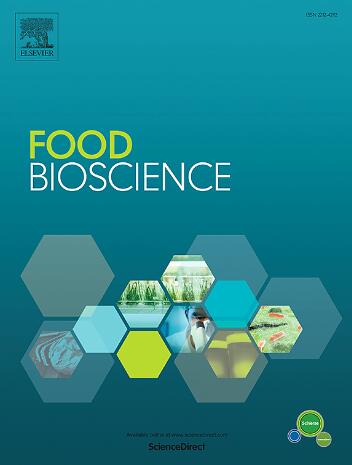Isolation, characterization, and bioactive properties of strawberry-derived nanoparticles
IF 4.8
1区 农林科学
Q1 FOOD SCIENCE & TECHNOLOGY
引用次数: 0
Abstract
Strawberries are nutrient-rich fruits with antioxidant function; however, research on strawberry-derived nanoparticles remains limited. In this study, nanoparticles were successfully isolated and extracted from strawberry juice. The antioxidant properties and active components of these nanoparticles were evaluated and compared using UV photometry and HPLC. SEM analysis revealed that the microstructure of the strawberry nanoparticles exhibit a vesicular microstructure. FTIR and NMR analyses indicated that the nanoparticles were primarily stabilized by hydrogen bonds. Furthermore, processing methods such as intense pulsed light treatment were found to influence molecular interactions during nanoparticle formation, enhancing π-π interactions and hydrophobicity. The Papp values and intestinal absorption rates of pelargonidin-3-glucoside (P3G) and cyanidin-3-glucoside (C3G) within the strawberry nanoparticles were significantly higher compared to their isolated forms. These findings provided valuable insights into the molecular interactions involved in nanoparticle formation and highlighted the physicochemical characteristics and enhanced functional properties of strawberry-derived nanoparticles.
草莓纳米颗粒的分离、表征和生物活性
草莓是营养丰富的水果,具有抗氧化功能;然而,有关草莓衍生纳米粒子的研究仍然有限。本研究成功地从草莓汁中分离和提取了纳米颗粒。使用紫外光光度法和高效液相色谱法对这些纳米颗粒的抗氧化特性和活性成分进行了评估和比较。扫描电子显微镜分析表明,草莓纳米颗粒的微观结构呈泡状。傅立叶变换红外光谱和核磁共振分析表明,纳米颗粒主要通过氢键稳定。此外,研究还发现强脉冲光处理等加工方法会影响纳米颗粒形成过程中的分子相互作用,增强π-π相互作用和疏水性。草莓纳米颗粒中的佩拉贡苷-3-葡萄糖苷(P3G)和青花素-3-葡萄糖苷(C3G)的 Papp 值和肠道吸收率明显高于它们的分离形式。这些发现为了解纳米颗粒形成过程中的分子相互作用提供了宝贵的见解,并突出了草莓衍生纳米颗粒的理化特性和增强的功能特性。
本文章由计算机程序翻译,如有差异,请以英文原文为准。
求助全文
约1分钟内获得全文
求助全文
来源期刊

Food Bioscience
Biochemistry, Genetics and Molecular Biology-Biochemistry
CiteScore
6.40
自引率
5.80%
发文量
671
审稿时长
27 days
期刊介绍:
Food Bioscience is a peer-reviewed journal that aims to provide a forum for recent developments in the field of bio-related food research. The journal focuses on both fundamental and applied research worldwide, with special attention to ethnic and cultural aspects of food bioresearch.
 求助内容:
求助内容: 应助结果提醒方式:
应助结果提醒方式:


